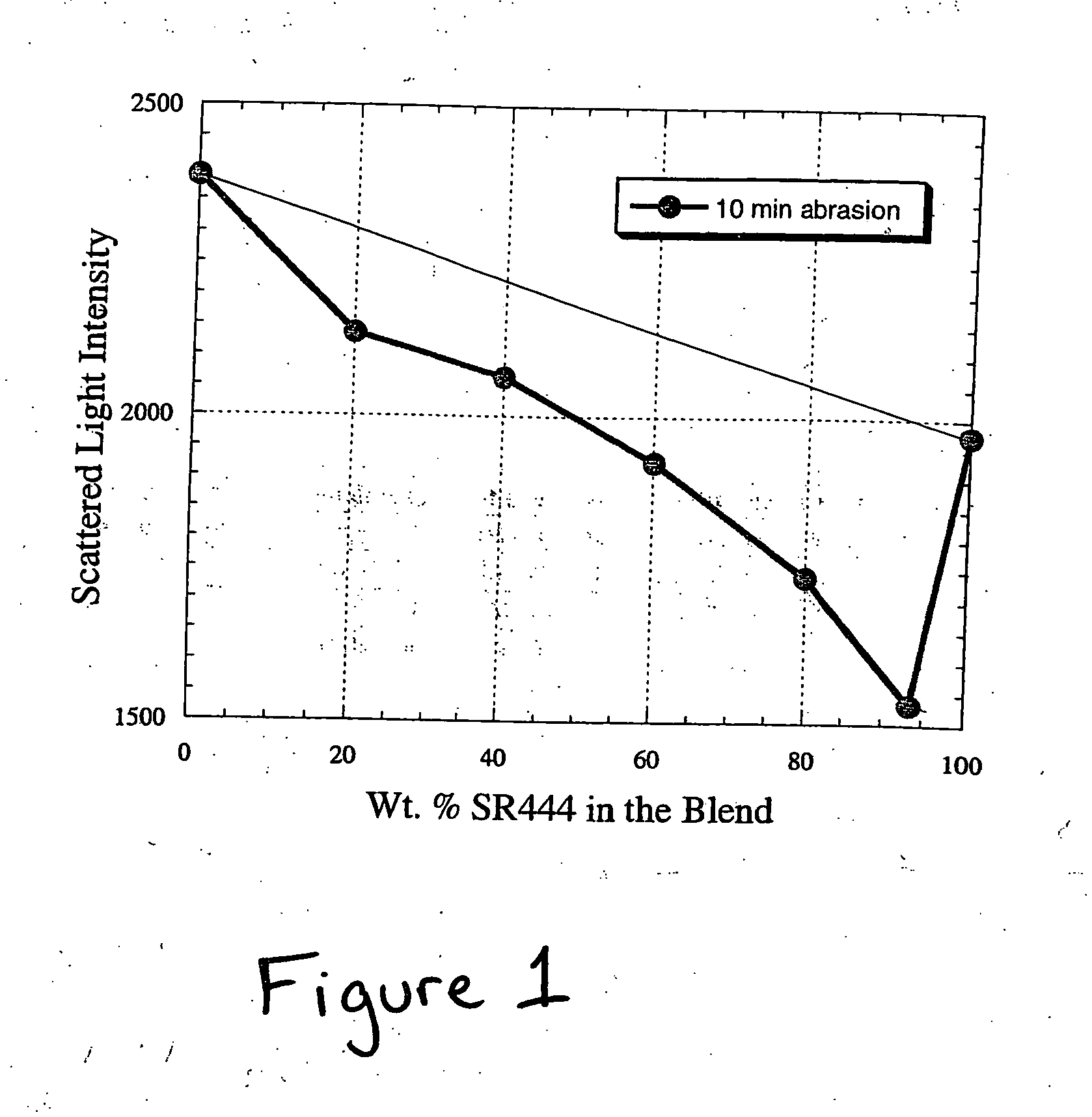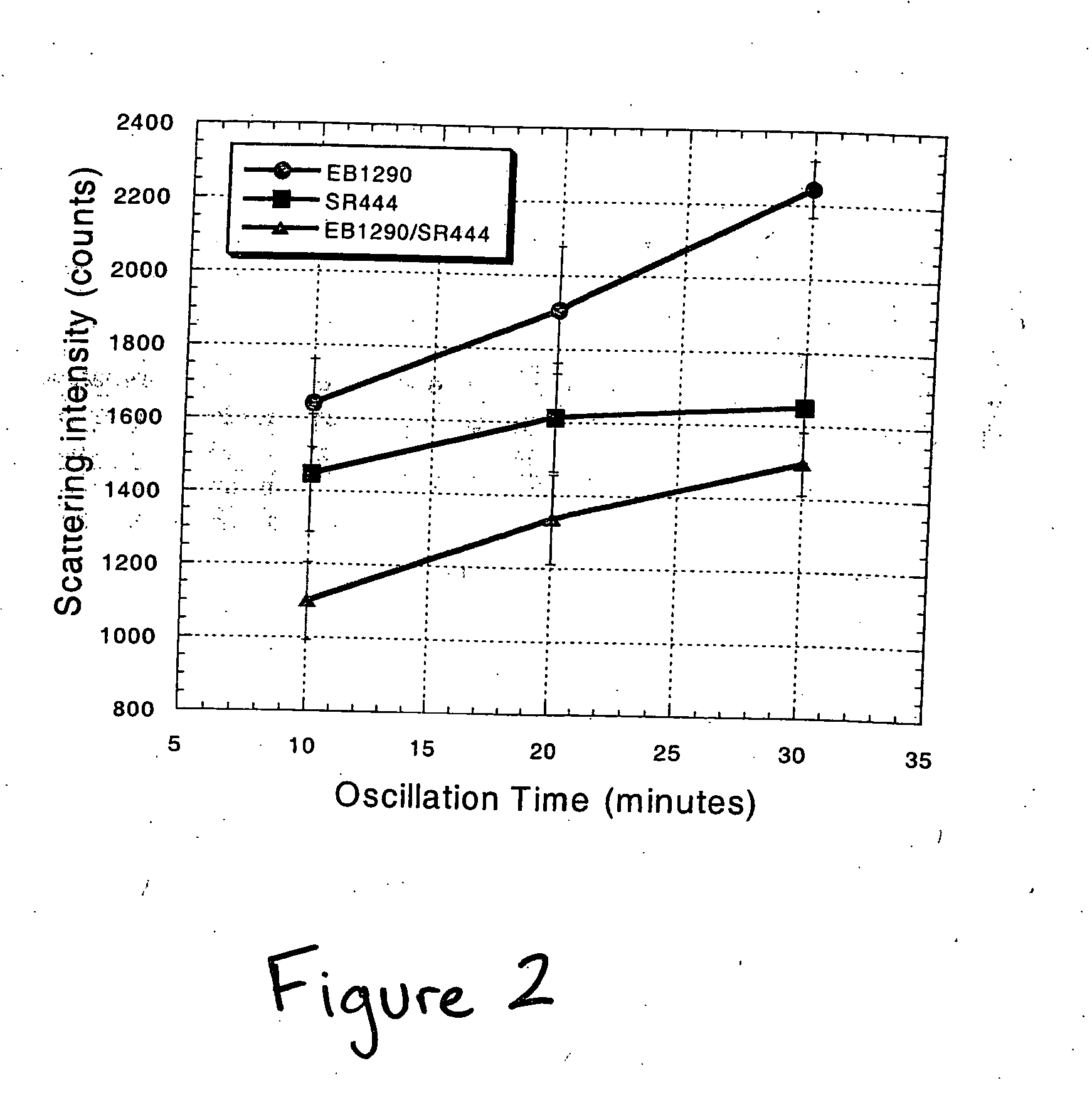UV curable coating compositions and uses thereof
a technology of coating compositions and uv, applied in the field of cureable coatings, can solve the problems of difficult and costly application of conventionally cured hardcoats, limited durability of known uv hardcoats, and difficulty in determining the durability of coating compositions, etc., and achieves the effect of convenient processing and improved physical and chemical properties
- Summary
- Abstract
- Description
- Claims
- Application Information
AI Technical Summary
Benefits of technology
Problems solved by technology
Method used
Image
Examples
example 1
[0034] Method for preparing the coating. The coatings were prepared by the following steps: automated deposition of multiple liquid coatings onto a substrate in an array format, spreading of the liquid across the substrate using centrifugal force, and curing of the array with UV light.
[0035] 10 milliliter stock solutions of hexafunctional urethane acrylate (EB1290) and pentaerythritol triacrylate (SR444) in 1-methoxy-2-propanol (0.2 grams of each acrylate per milliliter), DAROCUR 4365 (0.02 gram per milliliter) and FCS100 (0.1 gram per milliliter) were prepared. In addition, a 100 milliliter stock solution of Lumogen F Red was prepared, having a concentration of 0.0001 gram per milliliter in 1-methoxy-2-propanol. A PACKARD MULTIPROBE II EX robotic liquid handling system was employed to prepare the coatings. The robot was programmed such that each coating contained the composition shown in Table 2 when all of the solvent was evaporated from the coating. The solids content of each co...
example 2
[0038] The adhesion of the cured coatings to the polycarbonate substrate was measured using a modified version of ASTM procedure D3359. A robot was used to inscribe a crosshatch pattern onto each of the coatings. To each row of 8 coatings, Scotch Brand™ premium grade transparent cellophane tape from 3M was applied and then quickly ripped off without jerking at an angle of 180°. The amount of coating removed was determined using fluorescence microscopy, the contrast between the coating and the substrate being determined. The Lumogen F Red present in small amounts in the coatings strongly fluoresced when the coatings were illuminated at a wavelength of about 500 nm. Each coating in the array was observed using the microscope and rated according to ASTM D 3359 based on the amount of coating removed.
example 3
[0039] Abrasion testing of the coatings was conducted by abrading the entire array of coatings using a Glas-Col Multipulse shaker. The coating array was taped to the bottom of a tray with the array positioned in the center of the tray, and 1000 ml of quartz sand obtained from Global Drilling Supply (#4 Sand, Quartz) was poured on top of the array. The tray containing the array and sand was then oscillated in a circular motion at a speed setting of 50. Unless specified otherwise, the oscillation time was 20 minutes.
[0040] The degree of abrasion was measured from the intensity of scattered light using as described in U.S. Pat. No. 6,538,725. The instrument employed included a white light source (450-W Xe arc lamp, SLM Instruments, Inc., Ubrbana, Ill., Model FP-024), a monochromator for wavelength selection (SLM Instruments Inc., Model FP-092), and a portable spectrofluorometer (Ocean Optics, Inc., Dunedin, Fla., Model ST2000). The spectrofluorometer was equipped with a 200-μm slit, 6...
PUM
| Property | Measurement | Unit |
|---|---|---|
| wavelength | aaaaa | aaaaa |
| particle size | aaaaa | aaaaa |
| particle size | aaaaa | aaaaa |
Abstract
Description
Claims
Application Information
 Login to View More
Login to View More - R&D
- Intellectual Property
- Life Sciences
- Materials
- Tech Scout
- Unparalleled Data Quality
- Higher Quality Content
- 60% Fewer Hallucinations
Browse by: Latest US Patents, China's latest patents, Technical Efficacy Thesaurus, Application Domain, Technology Topic, Popular Technical Reports.
© 2025 PatSnap. All rights reserved.Legal|Privacy policy|Modern Slavery Act Transparency Statement|Sitemap|About US| Contact US: help@patsnap.com



